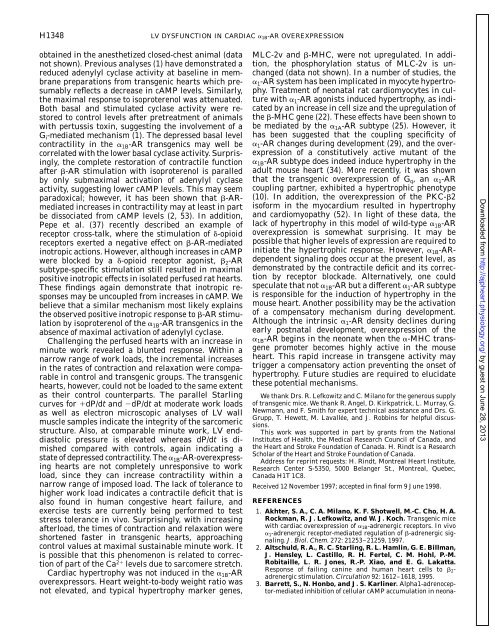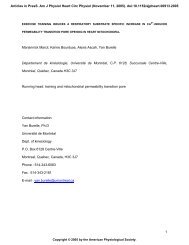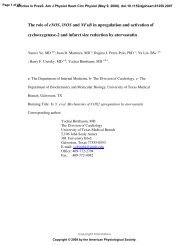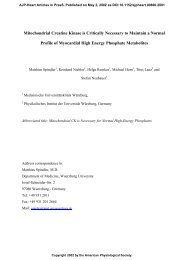Overexpression of 1B-adrenergic receptor induces left ventricular ...
Overexpression of 1B-adrenergic receptor induces left ventricular ...
Overexpression of 1B-adrenergic receptor induces left ventricular ...
You also want an ePaper? Increase the reach of your titles
YUMPU automatically turns print PDFs into web optimized ePapers that Google loves.
H1348 LV DYSFUNCTION IN CARDIAC <strong>1B</strong>-AR OVEREXPRESSION<br />
obtained in the anesthetized closed-chest animal (data<br />
not shown). Previous analyses (1) have demonstrated a<br />
reduced adenylyl cyclase activity at baseline in membrane<br />
preparations from transgenic hearts which presumably<br />
reflects a decrease in cAMP levels. Similarly,<br />
the maximal response to isoproterenol was attenuated.<br />
Both basal and stimulated cyclase activity were restored<br />
to control levels after pretreatment <strong>of</strong> animals<br />
with pertussis toxin, suggesting the involvement <strong>of</strong> a<br />
G i-mediated mechanism (1). The depressed basal level<br />
contractility in the <strong>1B</strong>-AR transgenics may well be<br />
correlated with the lower basal cyclase activity. Surprisingly,<br />
the complete restoration <strong>of</strong> contractile function<br />
after -AR stimulation with isoproterenol is paralled<br />
by only submaximal activation <strong>of</strong> adenylyl cyclase<br />
activity, suggesting lower cAMP levels. This may seem<br />
paradoxical; however, it has been shown that -ARmediated<br />
increases in contractility may at least in part<br />
be dissociated from cAMP levels (2, 53). In addition,<br />
Pepe et al. (37) recently described an example <strong>of</strong><br />
<strong>receptor</strong> cross-talk, where the stimulation <strong>of</strong> -opioid<br />
<strong>receptor</strong>s exerted a negative effect on -AR-mediated<br />
inotropic actions. However, although increases in cAMP<br />
were blocked by a -opioid <strong>receptor</strong> agonist, 2-AR<br />
subtype-specific stimulation still resulted in maximal<br />
positive inotropic effects in isolated perfused rat hearts.<br />
These findings again demonstrate that inotropic responses<br />
may be uncoupled from increases in cAMP. We<br />
believe that a similar mechanism most likely explains<br />
the observed positive inotropic response to -AR stimulation<br />
by isoproterenol <strong>of</strong> the <strong>1B</strong>-AR transgenics in the<br />
absence <strong>of</strong> maximal activation <strong>of</strong> adenylyl cyclase.<br />
Challenging the perfused hearts with an increase in<br />
minute work revealed a blunted response. Within a<br />
narrow range <strong>of</strong> work loads, the incremental increases<br />
in the rates <strong>of</strong> contraction and relaxation were comparable<br />
in control and transgenic groups. The transgenic<br />
hearts, however, could not be loaded to the same extent<br />
as their control counterparts. The parallel Starling<br />
curves for dP/dt and dP/dt at moderate work loads<br />
as well as electron microscopic analyses <strong>of</strong> LV wall<br />
muscle samples indicate the integrity <strong>of</strong> the sarcomeric<br />
structure. Also, at comparable minute work, LV enddiastolic<br />
pressure is elevated whereas dP/dt is dimished<br />
compared with controls, again indicating a<br />
state <strong>of</strong> depressed contractility. The <strong>1B</strong>-AR-overexpressing<br />
hearts are not completely unresponsive to work<br />
load, since they can increase contractility within a<br />
narrow range <strong>of</strong> imposed load. The lack <strong>of</strong> tolerance to<br />
higher work load indicates a contractile deficit that is<br />
also found in human congestive heart failure, and<br />
exercise tests are currently being performed to test<br />
stress tolerance in vivo. Surprisingly, with increasing<br />
afterload, the times <strong>of</strong> contraction and relaxation were<br />
shortened faster in transgenic hearts, approaching<br />
control values at maximal sustainable minute work. It<br />
is possible that this phenomenon is related to correction<br />
<strong>of</strong> part <strong>of</strong> the Ca 2 levels due to sarcomere stretch.<br />
Cardiac hypertrophy was not induced in the <strong>1B</strong>-AR<br />
overexpressors. Heart weight-to-body weight ratio was<br />
not elevated, and typical hypertrophy marker genes,<br />
MLC-2v and -MHC, were not upregulated. In addition,<br />
the phosphorylation status <strong>of</strong> MLC-2v is unchanged<br />
(data not shown). In a number <strong>of</strong> studies, the<br />
1-AR system has been implicated in myocyte hypertrophy.<br />
Treatment <strong>of</strong> neonatal rat cardiomyocytes in culture<br />
with 1-AR agonists induced hypertrophy, as indicated<br />
by an increase in cell size and the upregulation <strong>of</strong><br />
the -MHC gene (22). These effects have been shown to<br />
be mediated by the 1A-AR subtype (25). However, it<br />
has been suggested that the coupling specificity <strong>of</strong><br />
1-AR changes during development (29), and the overexpression<br />
<strong>of</strong> a constitutively active mutant <strong>of</strong> the<br />
<strong>1B</strong>-AR subtype does indeed induce hypertrophy in the<br />
adult mouse heart (34). More recently, it was shown<br />
that the transgenic overexpression <strong>of</strong> G q, an 1-AR<br />
coupling partner, exhibited a hypertrophic phenotype<br />
(10). In addition, the overexpression <strong>of</strong> the PKC-2<br />
is<strong>of</strong>orm in the myocardium resulted in hypertrophy<br />
and cardiomyopathy (52). In light <strong>of</strong> these data, the<br />
lack <strong>of</strong> hypertrophy in this model <strong>of</strong> wild-type <strong>1B</strong>-AR<br />
overexpression is somewhat surprising. It may be<br />
possible that higher levels <strong>of</strong> expression are required to<br />
initiate the hypertrophic response. However, <strong>1B</strong>-ARdependent<br />
signaling does occur at the present level, as<br />
demonstrated by the contractile deficit and its correction<br />
by <strong>receptor</strong> blockade. Alternatively, one could<br />
speculate that not <strong>1B</strong>-AR but a different 1-AR subtype<br />
is responsible for the induction <strong>of</strong> hypertrophy in the<br />
mouse heart. Another possibility may be the activation<br />
<strong>of</strong> a compensatory mechanism during development.<br />
Although the intrinsic 1-AR density declines during<br />
early postnatal development, overexpression <strong>of</strong> the<br />
<strong>1B</strong>-AR begins in the neonate when the -MHC transgene<br />
promoter becomes highly active in the mouse<br />
heart. This rapid increase in transgene activity may<br />
trigger a compensatory action preventing the onset <strong>of</strong><br />
hypertrophy. Future studies are required to elucidate<br />
these potential mechanisms.<br />
We thank Drs. R. Lefkowitz and C. Milano for the generous supply<br />
<strong>of</strong> transgenic mice. We thank R. Angel, D. Kirkpatrick, L. Murray, G.<br />
Newmann, and F. Smith for expert technical assistance and Drs. G.<br />
Grupp, T. Hewett, M. Lavallée, and J. Robbins for helpful discussions.<br />
This work was supported in part by grants from the National<br />
Institutes <strong>of</strong> Health, the Medical Research Council <strong>of</strong> Canada, and<br />
the Heart and Stroke Foundation <strong>of</strong> Canada. H. Rindt is a Research<br />
Scholar <strong>of</strong> the Heart and Stroke Foundation <strong>of</strong> Canada.<br />
Address for reprint requests: H. Rindt, Montreal Heart Institute,<br />
Research Center S-5350, 5000 Belanger St., Montreal, Quebec,<br />
Canada H1T 1C8.<br />
Received 12 November 1997; accepted in final form 9 June 1998.<br />
REFERENCES<br />
1. Akhter, S. A., C. A. Milano, K. F. Shotwell, M.-C. Cho, H. A.<br />
Rockman, R. J. Lefkowitz, and W. J. Koch. Transgenic mice<br />
with cardiac overexpression <strong>of</strong> <strong>1B</strong>-<strong>adrenergic</strong> <strong>receptor</strong>s. In vivo<br />
1-<strong>adrenergic</strong> <strong>receptor</strong>-mediated regulation <strong>of</strong> -<strong>adrenergic</strong> signaling.<br />
J. Biol. Chem. 272: 21253–21259, 1997.<br />
2. Altschuld, R. A., R. C. Starling, R. L. Hamlin, G. E. Billman,<br />
J. Hensley, L. Castillo, R. H. Fertel, C. M. Hohl, P.-M.<br />
Robitaille, L. R. Jones, R.-P. Xiao, and E. G. Lakatta.<br />
Response <strong>of</strong> failing canine and human heart cells to 2<strong>adrenergic</strong><br />
stimulation. Circulation 92: 1612–1618, 1995.<br />
3. Barrett, S., N. Honbo, and J. S. Karliner. Alpha1-adrenoceptor-mediated<br />
inhibition <strong>of</strong> cellular cAMP accumulation in neona-<br />
Downloaded from<br />
http://ajpheart.physiology.org/<br />
by guest on June 28, 2013






